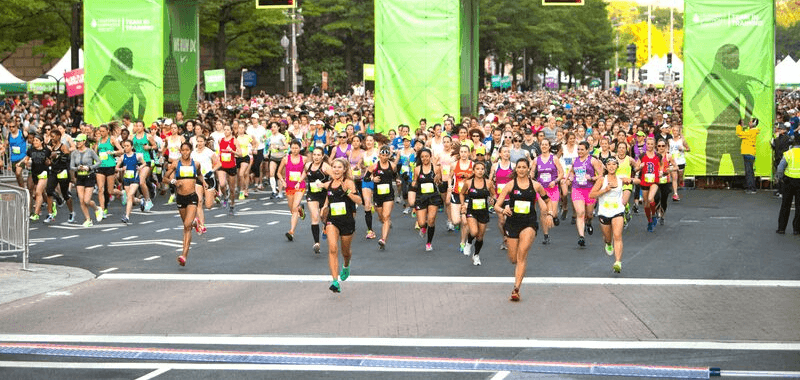Tabla de contenido
Feeling side stitches when running is the most common complaint among runners. Although it is not known exactly why they occur, there are known measures that can be taken to prevent and treat them.
What are the causes of running side stitches?
For the lucky ones who have never had their workouts interrupted by these side stitches, the pain is usually sharp and localized on one side of the body (usually the right) when doing a specific type of physical activity, usually with a high degree of intensity. For many runners, it ends up being torture.
There are several theories about how this discomfort originates. According to the newspaper El Comercio, medical specialist Julio Mena explains that a gas in the stomach puts pressure on the area and causes pain. “This gas presses a little on the spleen due to the muscular contraction during exercise.” Pain can also appear in the liver, chest, and back.
Spleen pain, or flatus, is also known in the scientific world as transient abdominal pain related to exercise. What is not known for sure is what causes it. The BBC quotes Dr. Ximena Muñoz, a nutritionist and specialist in Sports Medicine at the MEDS Clinic in Chile, explaining that “there are several theories regarding its origin.”
“One is that there is a redistribution of blood flow during exercise, and this generates an acute distension of the liver or spleen capsule, and this causes pain,” she explained. This hypothesis contrasts with several studies’ conclusions that “blood flow in the abdominal organs is reduced during exercise and therefore a dilatation of these organs cannot be completely explained.”

Other scientists have pointed out that these twinges arise from an overload or irritation in the diaphragm, which causes it to spasm and produce pain. The pain can be in the ligaments supporting the rib cage’s diaphragm. This overloading of the diaphragm can be caused by accelerated breathing or other factors, such as pre-race nutrition. Most scientists agree with this theory, but no definitive evidence exists.
Another theory suggests that posture may also be responsible for these running twinges. There are two possible explanations for this. The first is that poor running posture affects the nerves that run from the lower back to the abdomen. The second is that slouching increases friction on the peritoneum, the membrane that lines the abdominal cavity, causing pain.
Another theory suggests that posture may be responsible for these side stitches when running. There are two possible explanations for this. The first is that poor running posture affects the nerves that run from the lower back to the abdomen. The second is that slouching increases friction on the peritoneum, the membrane that lines the abdominal cavity, causing pain.

What to do to prevent running stitches?
Taking these two possible causes into account, here are some tips to prevent and treat side stitches while running
- Take care of your pre-workout/race nutrition: If you are going to eat before your run, try to eat about three hours before your workout. Unless it’s a small snack, you can do it up to 1 hour before. Also, avoid high-fat foods and try to remember what foods you ate before races where you experienced side bumps. This will give you an idea of what foods to avoid. On the other hand, it is crucial to stay hydrated when exercising. Take care of hydration throughout the day so you don’t arrive dehydrated to your workouts.
- Don’t forget to warm up: Starting physical activity without a warm-up can trigger a rapid and irregular breathing pattern, typical of a body that goes from a state of rest to one of moderate activity without an adaptation time. This irregular, rapid, and intense breathing pattern can cause the overuse of the diaphragm mentioned above. To avoid this, spend at least two to three minutes walking at a moderate pace, gradually increase to a gentle jogging pace, and then start your planned training session.
- Run like a swimmer: As a runner, you must learn to control your breathing. When running, we are often unaware of our breathing rhythm. Some studies indicate that most runners exhale in sync with the landing of one foot (right or left), leading to a 2:2 pattern (inhale for two steps and exhale for the same duration).
Some breathing techniques suggest that runners be mindful of their breathing rhythm and seek to carry an odd breathing pattern, preventing one side of the diaphragm from being subjected to more significant stress. A suggested breathing pattern is 3:2 (inhale for three steps, exhale for two steps).
As the pace quickens, the breathing rate will increase, and you can look for a 2:1 breathing rate there.
Recommended reading: Improve your endurance by training your breathing
- Watch your posture. It is essential to take care of your running posture. As mentioned above, some studies have shown that those who run with poor posture are more prone to develop lateral twinges.
Recommended reading: Saving energy by improving your form
- Take deep breaths to relieve pain. To reduce side stitches, slow down or, if the pain is very sharp, walk until the pain eases. While doing so, practice taking several deep breaths to relax the ligaments of the diaphragm.
The pain will decrease gradually. Once the pain disappears, do not resume physical activity abruptly. Start at a gentle pace and gradually increase your speed.
Source: Babble, The New York Times
Photo: Depositphoto
Looking for a plan that trains with you, not against you?
At running.COACH, we don’t just build a schedule. We create a smart, living plan that evolves with you. It understands your level, your race goals and your real life. Whether you sync your GPS watch or train straight from our iOS or Android app, your plan adjusts automatically as you improve.
From day one, you’ll feel the difference:
- A fully personalized, dynamic plan designed for you.
- Automatic sync and effortless workout tracking.
- Real-time updates when life happens, including missed sessions, new races or schedule changes.
- Simple, science-backed guidance to train smarter and recover faster.
🎁 Start today and enjoy your first 30 days free.
Because the best training plan isn’t one you follow. It’s one that follows you.app.











0 Comments